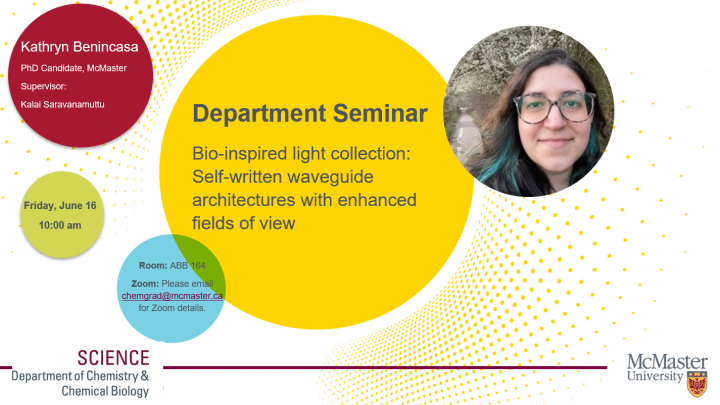PhD Seminar – Kathryn Benincasa
Jun 16, 2023
10:00AM to 11:00AM

Date/Time
Date(s) - 16/06/2023
10:00 am - 11:00 am
Title: Bio-inspired light collection: self-written waveguide architectures with enhanced fields of view
Date: Friday, June 16
Time: 10:00-11:00
Room: ABB 164
Zoom: email chemgrad@mcmaster.ca for Zoom details
Host: Kalai Saravanamuttu
Abstract: Photonic and optical materials found in nature are optimized for efficient light collection and light harvesting. Researchers have sought to understand these complex biological systems to design new functional materials for enhancing the efficiency of technologies such as photovoltaics, and sophisticated imaging systems. Taking inspiration from natural systems, our research aims to fabricate a range of advanced light collecting and light guiding architectures. These systems, which would be extremely challenging to fabricate through conventional techniques, are fabricated through a self-writing technique developed in our group. This method of waveguide fabrication is facile, operable with different wavelengths of light, and adaptable to different photosensitive materials.
Specifically, this seminar will describe the fabrication, characterisation, and application of slim (? 2mm), planar polymer films with different waveguide architectures. The first is a system comprising a radial array of cylindrical waveguides, which collectively exhibit a seamless enhanced, panoramic field of view (FOV). These structures also serve as beam shaping elements for light sources including light emitting diodes. The second structure consists of a conical array of waveguides, which possessed an omnidirectional FOV of ? 106°. The first of its kind, this waveguide encoded lattice demonstrates enhanced image capture when attached to a CMOS camera chip. Finally, exploiting the versatile nature of the waveguide self-inscription method, macro- and micro-structures of waveguides were fabricated in an electroactive hydrogel material. Reminiscent of the female angler fish and its bioluminescent lure, these hydrogel structures demonstrate remote controllable light guidance. By applying and varying and external electric field, both unidirectional and omnidirectional motion were achieved.
